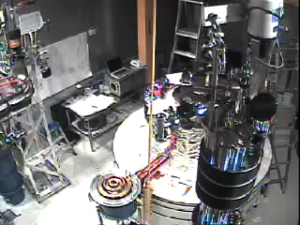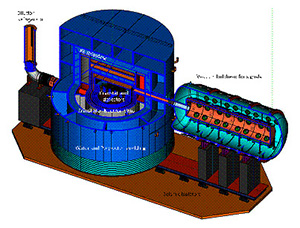The Cryogenic Dark Matter Search
The Cryogenic Dark Matter Search (SuperCDMS) experiment uses detectors made of germanium and silicon in an attempt to detect interactions of Weakly Interacting Massive Particles (WIMPs) that may constitute the dark matter observed in the universe. The detectors are cooled to temperatures very near absolute zero. Particle interactions in the crystalline detectors deposit energy in the form of heat, and in the form of charges that drift in an applied electric field. Special sensors on the faces of the cylindrical detectors convert this energy to electrical signals, which are then amplified and recorded in computers for later study. A comparison of the signal sizes, their relative timing, and their distribution between the two faces of the crystal allows the experimenters to tell whether the particle that interacted was more likely a WIMP, or one of the numerous conventional particles that come either from radioactive decays or from space in the form of cosmic rays. These background particles must be mostly filtered out if we are to see a WIMP signal. Layers of shielding materials, as well as the rock above the underground laboratory where the experiment is located, provide such background suppression.
Dan Bauer, CDMS project manager and Fermilab scientist, removes one tower of detectors used in the Cryogenic Dark Matter Search experiment at Soudan. Credit: Fermilab.
SuperCDMS Soudan is currently running 15 germanium detectors in the Soudan Underground Laboratory, in northern Minnesota. Recent results from the experiment have placed limits on the rate of light-mass WIMP interactions with nuclei. Such upper limits restrict theoretical models for WIMPs. Of particular recent interest are models that posit a “dark sector”, containing dark matter particles with dark forces analogous to the Standard Model of normal matter particles and forces.
The collaboration proposes to build a new experiment, SuperCDMS SNOLAB, with ~100 kg of germanium and silicon target mass at the SNOLAB underground laboratory in the Sudbury mine, Ontario, Canada. This experiment would be 100 times more sensitive to dark matter WIMPS than the current experiment, due to improvements in detector technology, as well as the deeper, cleaner underground laboratory space provided at SNOLAB.
The FCPA group working on SuperCDMS provides project and operations management, cryogenics, shielding and room temperature electronics design and fabrication, as well as expertise in data acquisition, computing and analysis. They are also working on a novel detector to measure neutrons that might mimic the WIMP signal expected in the SNOLAB experiment.
For more information on the experiment, please visit:
Team Members
- Ben Loer
- Lauren Hsu
- Dan Bauer
- Pat Lukens














